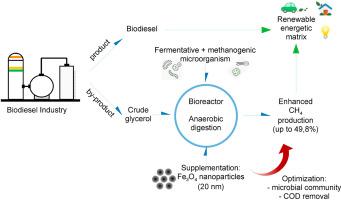Biomass & Bioenergy ( IF 5.8 ) Pub Date : 2022-04-05 , DOI: 10.1016/j.biombioe.2022.106439 Mateus Eugenio Boscaro 1 , Danieli Fernanda Canaver Marin 1 , Daiana Camila da Silva 1, 2 , Sandra Imaculada Maintinguer 1, 2, 3

|
This study investigated the effects of citrate-coated Fe3O4 nanoparticles in the anaerobic digestion of crude glycerol, the main by-product of the biodiesel industry. Fe3O4 nanoparticles were synthesized by the coprecipitation method and Scanning Electron Microscopy (SEM) characterized it. The method designed for synthesis produced stable Fe3O4 nanoparticles with diameters about 20 nm. Duplicate of anaerobic batch reactors (500 mL) were used for assessing the influence of Fe3O4 nanoparticles in four assays performed at 37 °C. The reactors were filled with anaerobic granular sludge; crude glycerol (25.0 g COD L−1); buffer solution; citrate-coated Fe3O4 nanoparticles suspension (0.2 g L−1; 0.4 g L−1 and; 0.8 g L−1 and a control without Fe3O4 nanoparticles); deionized water up to 250 mL. There were increases of 49.8%, 28.5% and 26.0% in the accumulated production of CH4 and 25.7%, 17.1% and 20.0% in the maximum rate of CH4 production in assays supplemented with 0.2, 0.4 and 0.8 g L−1 of Fe3O4 nanoparticles, respectively, in relation to control reactors. It was also observed a substantial increase on relative abundance of Bacteria and Archaea Domains, specially Bacteroides, Clostridiales, Methanomicrobiales and Methanosarcinales orders, after anaerobic digestion supplemented with Fe3O4 nanoparticles. The addition of Fe3O4 nanoparticles could improve the anaerobic digestion of crude glycerol, optimizing bacterial and archaeal communities enhancing the CH4 production.
中文翻译:

Fe3O4纳米颗粒对粗甘油厌氧消化微生物多样性和产气量的影响
本研究调查了柠檬酸盐包覆的 Fe 3 O 4纳米颗粒在厌氧消化粗甘油(生物柴油工业的主要副产品)中的作用。采用共沉淀法合成了Fe 3 O 4纳米粒子,并通过扫描电子显微镜(SEM)对其进行了表征。为合成而设计的方法产生了直径约为 20 nm 的稳定 Fe 3 O 4纳米粒子。厌氧间歇反应器的副本 (500 mL) 用于评估 Fe 3 O 4纳米颗粒在 37 °C 下进行的四次测定中的影响。反应器充满厌氧颗粒污泥;粗甘油(25.0 g COD L -1); 缓冲溶液;柠檬酸盐包覆的Fe 3 O 4纳米粒子悬浮液(0.2 g L -1;0.4 g L -1和;0.8 g L -1和没有Fe 3 O 4纳米粒子的对照);去离子水至 250 mL。在添加 0.2、0.4 和 0.8 g L -1的测定中,CH 4的累积产量分别增加了 49.8%、28.5% 和 26.0%, CH 4产生的最大速率分别增加了 25.7%、17.1% 和 20.0% 。铁3 O 4纳米粒子,分别与控制反应器有关。还观察到在补充有 Fe 3 O 4纳米颗粒的厌氧消化后,细菌和古生菌域的相对丰度显着增加,特别是拟杆菌属、梭状芽胞杆菌目、甲烷微生物目和甲烷毒蕈目目。Fe 3 O 4纳米颗粒的添加可以改善粗甘油的厌氧消化,优化细菌和古菌群落,提高CH 4产量。









































 京公网安备 11010802027423号
京公网安备 11010802027423号